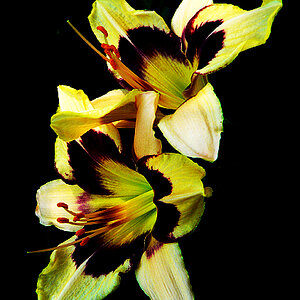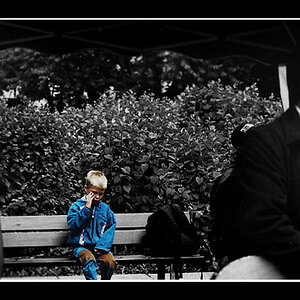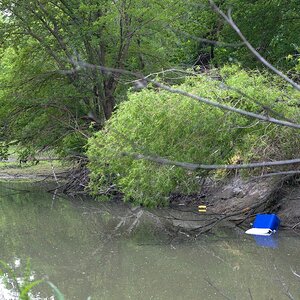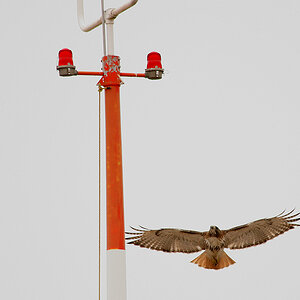Navigation
Install the app
How to install the app on iOS
Follow along with the video below to see how to install our site as a web app on your home screen.

Note: This feature currently requires accessing the site using the built-in Safari browser.
More options
You are using an out of date browser. It may not display this or other websites correctly.
You should upgrade or use an alternative browser.
You should upgrade or use an alternative browser.
one quick question
- Thread starter s3rocks
- Start date
Tiberius47
No longer a newbie, moving up!
- Joined
- Oct 4, 2007
- Messages
- 742
- Reaction score
- 47
- Can others edit my Photos
- Photos NOT OK to edit
There's no set number of lenses. Look at the focal lengths. If the shortest focal length is say 10mm (wide angle), then multiply it by twelve and you get 120mm. So if you have lenses that give you a range of 10-120mm, this will give you a 12 times zoom (spread over different lenses, no doubt).
The lenses I have for my camera give me the equivilent of a 16 times zoom, and this is over three zoom lenses.
The lenses I have for my camera give me the equivilent of a 16 times zoom, and this is over three zoom lenses.
solrac8126
TPF Noob!
- Joined
- Oct 8, 2007
- Messages
- 120
- Reaction score
- 0
- Location
- Panama
- Can others edit my Photos
- Photos OK to edit
hey I'm getting myself that same camera , and i bought the canon 70-300 lens, which i believe is the same 12X zoom my s5 had,
is that right?
is that right?
Buszaj
TPF Noob!
- Joined
- May 23, 2007
- Messages
- 521
- Reaction score
- 0
- Location
- Toronto
- Can others edit my Photos
- Photos OK to edit
I think that what you are looking for is the reach when you say 12x zoom. Look on the camera, on the lens, it usually says some measurement, equivalent to 35mm. I'm pretty sure that this means that if you were getting a lens for a full-frame, you would need a lens that has that max amount of millimetres. So, let's say your camera has 35-420, you need 420mm on the long end on the lens to get the same reach as your S3. But, since the 400D has 1.6 crop factor, I think you divide your max amount by 1.6 to get the amount that you need. I saw this explanation in a thread a while ago, don't remember which one, so I explained. Have fun with your camera!
solrac8126
TPF Noob!
- Joined
- Oct 8, 2007
- Messages
- 120
- Reaction score
- 0
- Location
- Panama
- Can others edit my Photos
- Photos OK to edit
The S5IS has a 6mm-72mm (equiv 35mm FoV to 36mm-432mm) lens.
The kit has an 18mm-55mm lens (equiv 35mm FoV to 29mm-88mm).
this is the info i got from dave_s93 on another forum
he also recommend to get a 70-300 tamron , but was to late since i already purchased the canon
The kit has an 18mm-55mm lens (equiv 35mm FoV to 29mm-88mm).
this is the info i got from dave_s93 on another forum
he also recommend to get a 70-300 tamron , but was to late since i already purchased the canon
Garbz
No longer a newbie, moving up!
- Joined
- Oct 26, 2003
- Messages
- 9,713
- Reaction score
- 203
- Location
- Brisbane, Australia
- Website
- www.auer.garbz.com
- Can others edit my Photos
- Photos NOT OK to edit
One, two or three. Depending on the money you want to spend and the image quality you get.
One is the cheapest quality. But large zoom ranges means poor sharpness and often shocking barrel distortions.
Three gives you the best quality usually. Many of the most expensive and nicest lenses have shorter zoom ranges.
One is the cheapest quality. But large zoom ranges means poor sharpness and often shocking barrel distortions.
Three gives you the best quality usually. Many of the most expensive and nicest lenses have shorter zoom ranges.
Great info guys, do you have any recomendations?
What about the 70-300 solrac8126 is talking about, would that go as far as 12x?
I'll basically will purchase the kit lenses and stick whit it a couple of months , but i will like to have the macro lense and the zoom lense as well, so i can at least use the 400d the same as the s3
What about the 70-300 solrac8126 is talking about, would that go as far as 12x?
I'll basically will purchase the kit lenses and stick whit it a couple of months , but i will like to have the macro lense and the zoom lense as well, so i can at least use the 400d the same as the s3
soylentgreen
TPF Noob!
- Joined
- Feb 27, 2007
- Messages
- 735
- Reaction score
- 2
- Location
- Miami, FL
- Can others edit my Photos
- Photos NOT OK to edit
The 70-300 with the kit lens should last you a while unless you upgrade for better image quality. Mix in a 50 f/1.8 and a nice macro lens and you have a great starting kit. Go for the updates 70-300 with IS. Canon added better glass and IS to boost performance over the earlier non-IS models.
Garbz
No longer a newbie, moving up!
- Joined
- Oct 26, 2003
- Messages
- 9,713
- Reaction score
- 203
- Location
- Brisbane, Australia
- Website
- www.auer.garbz.com
- Can others edit my Photos
- Photos NOT OK to edit
I think you are misunderstanding how things work. This 4x or 8x zoom rating on normal point and shoot cameras tell you nothing of the focal length of the final image. It is just how much an image can be zoomed by with the lens.
The Nikkor 18-200mm is a 200/18 = 11.1x zoom. The Canon 70-300 is a 4.28x zoom. That said it has a longer focal length than the nikon and is practically useless for any kind of wider angle photography like architecture or landscape photos. The Nikkor 200-400 is only a 2x zoom yet it is probably useful only for stalking people and chasing birds and sports. The zoom factor is low but it is a most drool worthy lens.
Macro is also a term blindly thrown around by many P&S camera manufacturers. Indeed some of the Canon Powershot series have a "macro" feature which produces a severely barrel distorted image which is no where near what people with actual Macro lenses would call macro.
So to get into the real realm of thinking (and these are corrected values for the Canon 400D. Multiply by 1.6 to get the values for 35mm.:
Wide angles like landscapes and buildings are usually in the 16-28mm range.
Standard mid ranges are around 28-50mm.
Beyond 50-100mm you start getting into longer portrait lenses and some basic nature animal photography and such.
+100mm if you like sports, bird watching, and that sort of thing.
For macro lenses are rated in ratios. 1:1 means an object sized 1cm will be projected on the film plane 1cm 1:2 means a 1cm object will be 5mm across the film plane. Bearing in mind that your sensor is ?26mm? across if you take at the closes possible focusing point an object that is 26mm it will fill the frame entirely.
Now with that in mind you can start thinking of what you need. Standard kit lenses range from 18-70 18-55 18-135 for the Nikons I assume the canons are similar. The 70-300 would be best for sports and nature type photos. And a cheap lens with macro that has something like a 1:3 or 1:4 ratio should be similar to what you pull from the "macro" function of a point and shoot, but if you want 1:1 you'll need a dedicated lens which is locked in on one focal length, and you'll need to zoom with your feet.
The Nikkor 18-200mm is a 200/18 = 11.1x zoom. The Canon 70-300 is a 4.28x zoom. That said it has a longer focal length than the nikon and is practically useless for any kind of wider angle photography like architecture or landscape photos. The Nikkor 200-400 is only a 2x zoom yet it is probably useful only for stalking people and chasing birds and sports. The zoom factor is low but it is a most drool worthy lens.
Macro is also a term blindly thrown around by many P&S camera manufacturers. Indeed some of the Canon Powershot series have a "macro" feature which produces a severely barrel distorted image which is no where near what people with actual Macro lenses would call macro.
So to get into the real realm of thinking (and these are corrected values for the Canon 400D. Multiply by 1.6 to get the values for 35mm.:
Wide angles like landscapes and buildings are usually in the 16-28mm range.
Standard mid ranges are around 28-50mm.
Beyond 50-100mm you start getting into longer portrait lenses and some basic nature animal photography and such.
+100mm if you like sports, bird watching, and that sort of thing.
For macro lenses are rated in ratios. 1:1 means an object sized 1cm will be projected on the film plane 1cm 1:2 means a 1cm object will be 5mm across the film plane. Bearing in mind that your sensor is ?26mm? across if you take at the closes possible focusing point an object that is 26mm it will fill the frame entirely.
Now with that in mind you can start thinking of what you need. Standard kit lenses range from 18-70 18-55 18-135 for the Nikons I assume the canons are similar. The 70-300 would be best for sports and nature type photos. And a cheap lens with macro that has something like a 1:3 or 1:4 ratio should be similar to what you pull from the "macro" function of a point and shoot, but if you want 1:1 you'll need a dedicated lens which is locked in on one focal length, and you'll need to zoom with your feet.
Tiberius47
No longer a newbie, moving up!
- Joined
- Oct 4, 2007
- Messages
- 742
- Reaction score
- 47
- Can others edit my Photos
- Photos NOT OK to edit
hey I'm getting myself that same camera , and i bought the canon 70-300 lens, which i believe is the same 12X zoom my s5 had,
is that right?
Nope. The 70-300 lens by itself has a range of 4 times or so. That means that when you zoom in, you are seeing things four times bigger.
Mike_E
No longer a newbie, moving up!
- Joined
- Jan 26, 2007
- Messages
- 5,327
- Reaction score
- 266
- Can others edit my Photos
- Photos OK to edit
S3rocks, I'm sorry but forget trying to replicate your P&S.
Start thinking about what you want to shoot most right now and get a lens for that.
After you've gotten that out of your system and have a much better feel for your new camera then you will have a better idea which lens to get next.
It may well be that you won't want what you would buy right now.
Start thinking about what you want to shoot most right now and get a lens for that.
After you've gotten that out of your system and have a much better feel for your new camera then you will have a better idea which lens to get next.
It may well be that you won't want what you would buy right now.
solrac8126
TPF Noob!
- Joined
- Oct 8, 2007
- Messages
- 120
- Reaction score
- 0
- Location
- Panama
- Can others edit my Photos
- Photos OK to edit
Nope. The 70-300 lens by itself has a range of 4 times or so. That means that when you zoom in, you are seeing things four times bigger.
I see, well i guess it's ok now. I'm going to wait to see what happens when i get the camera.
Garbz your post was really intersting for me too, however i don't know if i understood it the way is supposed. I don't know if there is a place (webiste) where i can see more of that info.
For instance i found this
"Teleconverters
Unless you have a budget in the thousands, it is pretty difficult to find a digital camera that offers more than a 12x optical zoom (approx. 400mm in SLR terms). If you take into account the fact that you need a 400mm-600mm lens for most surf photo conditions, you need to explore other options if you want some serious photos. One way to get round this is to add a teleconverter. These usually come in 1.5x or 2x.
A disadvantage of teleconverters is that they do reduce the amount of light able to enter the lens, which in turn affects the speed/quality at which you can capture action."
Here
S3rocks, I'm sorry but forget trying to replicate your P&S.
Start thinking about what you want to shoot most right now and get a lens for that.
After you've gotten that out of your system and have a much better feel for your new camera then you will have a better idea which lens to get next.
It may well be that you won't want what you would buy right now.
gosh i just want like a all around lens haha,
I now it doesn't work that way so it's ok. I was doing my math by dividing the focal lens and still i can't find a "12x" lens, also and bare with me if this is way to dumb but i;ve seen lenses that have less focal range and fisicaly are bigger !!
This is gaetting complicated hehe , i also saw a couple of those "L" lenses are those for spacial stuff or what i saw 3k+ lenses i wonder if they realy worth that at least how much money does cost one of them for canon, and the revenue they get on each one of them.
I've order the canon with the kit lense.
also thanx solrac for the teleconverters info
sabbath999
No longer a newbie, moving up!
- Joined
- Apr 11, 2007
- Messages
- 2,701
- Reaction score
- 71
- Location
- Missouri
- Can others edit my Photos
- Photos OK to edit
"Teleconverters
Unless you have a budget in the thousands, it is pretty difficult to find a digital camera that offers more than a 12x optical zoom (approx. 400mm in SLR terms). If you take into account the fact that you need a 400mm-600mm lens for most surf photo conditions, you need to explore other options if you want some serious photos. One way to get round this is to add a teleconverter. These usually come in 1.5x or 2x.
A disadvantage of teleconverters is that they do reduce the amount of light able to enter the lens, which in turn affects the speed/quality at which you can capture action."
The critically important thing about tele-converters is that they magnify the lens... This sounds patently obvious, but the thing you have to consider is that every flaw or weakness in the lens becomes much more obvious with a tele-converter attached to it.
If you are going to use the TC on a pristine lens, like say a 400mm f2.8 prime, then it will prolly work pretty well because the lens is so excellent. If you are going to use it on a third party cheap 70-300 f/4.5-6.3, then you had better expect some heavy duty Holga type action.
Similar threads
- Replies
- 3
- Views
- 133
- Replies
- 7
- Views
- 353
- Replies
- 0
- Views
- 178
- Replies
- 18
- Views
- 1K



![[No title]](/data/xfmg/thumbnail/37/37112-9474bbad05f760cbef79df3379b23509.jpg?1619737882)

![[No title]](/data/xfmg/thumbnail/42/42458-8274869c9294d2f0655f80c8f0e6048c.jpg?1619740191)






